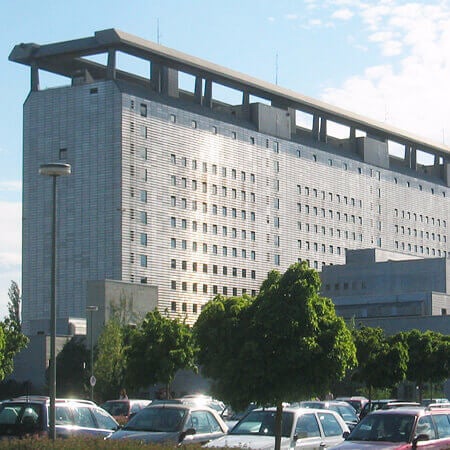Cancer of the bladder is not very active at the stage 1-3, and it is easy to write off the symptoms to a trivial infection of the genitourinary tract. As the pathology progresses, more pronounced symptoms arise and more comprehensive therapy is required. Bladder cancer treatment in Europe demonstrates good results, but it is important to detect the pathology and start therapy as early as possible.
Bladder neck cancer is a rare type of cancer that occurs in the tissues at the base of the bladder where it connects to the urethra (urinary tube).
Symptoms of bladder neck cancer may include difficulty urinating, frequent urination, blood in the urine, pain during urination, pelvic pain, and urinary tract infections.
Diagnosis includes a review of the medical history, physical examination, imaging tests such as CT scans or MRI, cystoscopy to examine the bladder and urethra, and often a biopsy to examine tissue for cancer cells.
Treatment options for bladder neck cancer may include surgery, chemotherapy, radiation therapy, immunotherapy, and targeted therapy, depending on the stage of cancer.
The prognosis for bladder neck cancer depends on the stage of the cancer, the type of tumor, and the response to treatment. Early detection and comprehensive treatment can improve outcomes.
What does cancer of the bladder neck mean?
Often, bladder cancer originates in the neck, in the ureteric triangle, and on the posterior and lateral walls of the bladder.
Bladder cancer can have different degrees of malignancy. As for bladder cancer that can be considered the most benign, it localizes in a small bladder area, resulting in the formation of adenomas, polyps, and other formations. Malignant tumors include bladder cancer that is represented by more aggressive neoplasms. Such bladder cancer is characterized by the involvement of the submucosa and deeper tissues (invasive bladder cancer, muscle invasive bladder cancer). As the pathologically altered epithelial cells progress, the tumor grows all over the bladder wall and physicians detect that cancer has spread to other organs.
Almost 80% of patients are 50-80 years old, with the research identified disease's peak at the age of 70. Men get diagnosed with the bladder cancer more often than women: according to the frequency of development among all malignant tumors, bladder cancer occupies 11th place in women and the fifth one in men. In men, the bladder cancer tends to be diagnosed at a younger age and is more aggressive. However, in women, if a muscle invasive bladder cancer is detected beyond the stage one-three, there are more risks and fewer chances for survival. Due to anatomical reasons, cancer of the bladder neck develops more often in men. In their genitourinary system, there is a prostate gland, through which the upper part of the urethra goes. And basically, it should be remembered that cancer of the bladder neck is often not an independent pathology, but it develops along with inflammation of the bladder wall or prostate cancer.
Timely diagnosis making and start of treatment of bladder cancer can stop the process and completely eliminate the disorder without negative consequences.
Symptoms of cancer of the bladder neck
The initial stages of the bladder cancer are often asymptomatic, causing no concerns to the patient. One of the first signs of the health condition is often hematuria (staining of the urine with blood), the intensity of which can vary. From slight, when the urine becomes pink in color, to the formation of blood clots, which leads to the bladder tamponade and acute urinary retention. At the beginning of the health condition, bleeding is sometimes more of a one-time thing and it doesn’t recur for a long time, thus, delaying the necessary examination. Therefore, at any episode of hematuria, it is necessary to identify its causes by performing a comprehensive examination.
Pain syndrome in people with bladder cancer can have different characteristics depending on the spread of the tumor. If the tumor is locally spread, the initial pain is most often located over the pubis and provoked by the act of urination; later it becomes constant and appears in the perineum and sacral region. If the tumor obstructs the ureteral mouth, hydronephrosis develops, there is a pain in the lumbar region, positive tapping of the lumbar region, palpation of the enlarged kidney. Bone pain usually indicates a metastatic lesion of the skeleton.
As the process progresses and the volume of the lesion increases, other symptoms join. Frequent painful, sometimes difficult urination, pain in the lower abdomen, then in the perineum, inguinal area and sacrum become troublesome. At first, the pains occur when the bladder is full, but later they become constant. The intensity of the pain depends on the degree of bladder wall invasion.
As the diagnosis progresses, the bladder capacity decreases, bleeding episodes become more frequent, which leads to anemia and deterioration of the patient's general health condition. An important thing to know is when the bladder neck and ureters are affected, renal function gradually deteriorates, chronic renal failure develops, urinary infection sets in, which, in more severe cases, can lead to the death of the patient without timely surgery or treatment.
At advanced stages, general weakness, pain in the lumbar and inguinal areas, abdominal pain, lack of appetite and weight loss, fever, swelling of the legs, enlarged lymph nodes join cancer manifestations. Fistulas may appear between the bladder and the rectum.
It is important to know that the above signs (impaired urination, pain, and bleeding) may be symptoms of other diseases of the urinary tract. They are also indicative of urinary tract infections (cystitis, prostatitis), tuberculosis, urolithiasis, benign prostatic hyperplasia, sclerosis of the bladder neck, etc. Bladder cancer patients often undergo prolonged and ineffective treatment in an outpatient clinic. Based only on laboratory parameters (urine and blood tests) and ultrasound findings, specialists at the pre-hospital stage are often unable to make a correct diagnosis, which leads to late initiation of necessary treatment.
Treatment tactics
Bladder cancer is treated in different ways, applied either individually or in combination. Because of the multifaceted nature of the diagnosis and the different prognoses for bladder cancer, the most accurate determination of the tumor spreading and the correct classification of the tumor type by the health provider are necessary to choose the best treatment.
If the tumor is superficial and has not spread beyond the bladder mucosa, transurethral resection of the bladder is performed. During the surgery, the tumor is resected and the bleeding vessels are cauterized (coagulated) with a resectoscope placed through the urethra. To reduce the risk of recurrence, a one-time cytostatic bladder lavage is performed during or immediately after the procedure. After treatment of superficial cancers with a high risk of recurrence, multiple cytostatic bladder lavage is performed.
If the bladder cancer has invaded the muscle tissue, or if there is a risk of this, a radical surgery (total cystectomy), i.e. the removal of the bladder and the prostate gland, is the most suitable medical procedure to perform. In this case, the urine is drawn into a reservoir that is created from a part of the intestine and serves as a bladder. In other cases the urine reservoir can be led outside through a special opening, a stoma.
In men, the prostate gland is usually also removed during surgery, but the urethra is usually preserved in modern medical practice. In women, the urethra, uterus, and related organs are usually removed. If surgery is not possible due to the poor general health condition or if the tumor is difficult to reach, radiotherapy or chemotherapy options are considered.
At the time of diagnosing the pathology, only about 5% of patients have metastases. Such cases require the use of radiation therapy or chemotherapy instead of surgery. Depending on the type of tumor, its size, and the presence of metastases, radiation therapy and intravenous treatment with cytostatic drugs are also possible. In eligible patients the chemoradiation therapy demonstrates as good results as a traditional surgery, the latest research studies state. If the tumor has metastasized, radiation therapy is used to relieve symptoms, such as pain, incontinence, caused by the large size of the tumor, and blockage of the urinary tract. Chemotherapy is used to treat metastases: they shrink and the symptoms of the disease become less pronounced.
Surgical options for cancer of the bladder neck
When choosing treatment options for the cancer of the bladder neck, the diagnosis is conventionally divided into the superficial one (growing in the lumen), which affects only the mucous membrane, and muscle invasive bladder cancer, i.e. involving the muscular layer of the bladder wall.
Transurethral resection of the bladder is the optimal treatment for superficial cancer. This method uses a special endoscopic technique, which allows the tumor to be removed through the urethra. In this surgery, sequential removal of the tumor is performed using an electric tool loop. Transurethral resection preserves the tumor with all its layers for histological examination, which facilitates correct staging of cancer. This is important for making prognosis and determining further treatment tactics. However, several factors limit the appliance of this type of surgery. According to the latest research information, only a little more than 5% of patients have absolute indications for bladder resection, and the question about the necessity of application of surgery in invasive cancer has not been solved definitively. In the presence of small tumors, evaporation of pathological tissue using high temperatures is possible.
Transurethral surgery is usually suitable at the initial stages of cancer with small volumes of affected tissues of the bladder neck. Endotracheal or spinal anesthesia is used under the supervision of an experienced anesthesiologist present at surgery. The doctor inserts a high-quality video camera-equipped resectoscope into the canal and performs excision of the affected tissue.
Open resection (removal of part of the bladder with the tumor) in superficial cancer, on the contrary, is rarely used nowadays. It is indicated only if there is a tumor, removal of which with transurethral surgery is associated with more risks. This group of tumors includes large tumors at the apex of the bladder. Bladder resection can be performed in a small number of carefully selected patients with a single primary invasive tumor no more than 5-6 cm in diameter that is localized on the moving walls at least 3 cm from the neck. Large-volume surgery with removal of half of the affected organ or more, plastic replacement of the bladder wall defect, and resection for bladder cancer lesions in the neck area are not performed in such cases because of high relapse rate.
The partial resection of the bladder neck can be an option for extensive lesions of the organ's neck. It consists of dissecting the modified tissue to open the lumen necessary for normal urination. The open position of the neck is maintained with a temporary catheter, which is removed in the postoperative period. The result allows a complete restoration of the natural function of the urinary system.
Can bladder cancer be prevented?
It is necessary to be attentive to your health and consult a doctor at the first, even minor, signs of the disease. It is important to know the information on the first signs of cancer, monitor the regularity of urination, protect against urogenital infections, diagnose and treat inflammatory processes of the urinary tract in time. Workers of harmful industries should not neglect occupational examinations. It is recommended that people over the age of 40 also undergo annual check-ups for bladder cancer.
The cost of treatment in Europe
Leading European hospitals accept patients with bladder cancer even during the lockdown. The cost of treatment in Europe might not be much higher than the one offered by private clinics in your native country. However, European hospitals offer treatment of high quality, which is amazing, since this disease requires the use of a large number of resources. However, the total cost of treatment may be somewhat higher due to the cost of travel and prices for accommodation in Europe.
Generally, the cost of treatment in Europe is the following:
- The prices for the diagnostics of cancer of the bladder neck start at 886 EUR
- The cost of treatment in Europe with transurethral resection with subsequent plasty starts at 9,209 EUR
- The prices for bladder cancer rehabilitation start at 951 EUR per day
With Booking Health, there are European hospitals ready to accept a patient for treatment right now and provide the best services for proper diagnosis making and further therapy.
Also, feel free to contact Booking Health for more information regarding the cost of treatment in European hospitals.
Bladder cancer treatment with Booking Health
Many patients give up and despair when being diagnosed with cancer. It should be remembered that, according to statistical research, there is a chance of survival even in those severely ill patients whose bladder cancer was detected at the advanced stage. You can improve your chances of regaining health by seeing a doctor timely and entrusting therapy to experienced specialists who use modern equipment and advanced bladder cancer treatment methods.
Bladder cancer treatment with Booking Health is a stress-free experience, which many cancer patients need. Booking Health makes treatment in Europe convenient through the services the company provides, which include the paperwork, communication with the chosen hospital, visa issuing, providing an interpreter for bladder cancer treatment duration, helping to keep in contact with the health provider in Europe, and much more.
You can get full information about bladder cancer treatment in Europe on the Booking Health website. By sending the request you’ll get information about the price, the hospital selection, and general advice on the options for treatment in European hospitals.
Authors:
The article was edited by medical experts, board certified doctors Dr. Nadezhda Ivanisova and Dr. Sergey Pashchenko. For the treatment of the conditions referred to in the article, you must consult a doctor; the information in the article is not intended for self-medication!
Our editorial policy, which details our commitment to accuracy and transparency, is available here. Click this link to review our policies.
Sources:
National Library of Medicine
Sage Journals
Science Direct
















